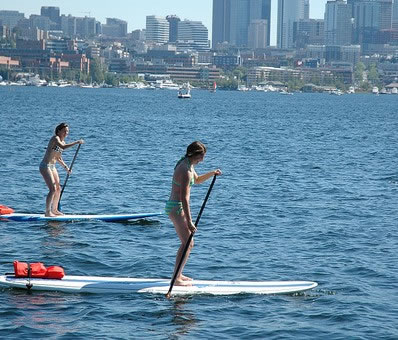It may look like the lovechild of a gondola and a surfboard, but this week’s Grobby (that’s Greatist lingo for hobby) is actually a rediscovered Hawaiian sport with a heritage stretching back to ancient island kings. With its popularity skyrocketing from Honolulu to Venice (Beach) and beyond, Stand Up Paddleboarding (SUP) is riding the dual wave of a killer core workout and serious good time.
Catching Waves (and a Workout) — The Need-to-Know
 First, picture a gondola. Now swap the boat for an over-sized epoxy/polystyrene longboard, switch the wooden oar for a carbon-fiber paddle, and then trade the canals for an open sea. It’s still the same basic idea: stand on a floating raft, carry a big stick, and go for a leisurely water tour from point A to point B.
First, picture a gondola. Now swap the boat for an over-sized epoxy/polystyrene longboard, switch the wooden oar for a carbon-fiber paddle, and then trade the canals for an open sea. It’s still the same basic idea: stand on a floating raft, carry a big stick, and go for a leisurely water tour from point A to point B.
But there are two key differences between SUP and the Venetian water taxi. First, there’s the burn. A surfboard, even SUP’s eleven foot long, five inch thick, and thirty inch wide version, can wobble and pitch like a BOSU and riders will need to constantly recruit the back, core, and legs to stay upright. And where our dapper gondolier could rock his oar using the boat as a fulcrum, a SUP rig has no such aid. The core and upper body must work together to create the driving force behind each stroke.
The second differentiating factor is the open ocean. On a calm day with glassy water, most SUP enthusiasts will have no problem. But add some waves and a light breeze, and expect to hang on tight. Then again, it’s all part of the fun: with enough thrust, a stand up paddleboard can catch and ride waves like a traditional surfboard. While the paddling itself is a fun, complete workout for people at any level, many expert SUP lovers can’t help but heed the surf’s call. And what the large boards trade in mobility (don’t expect any 360° aerials from an 11-footer) they make up for in glide. With a few strokes, the experienced SUP paddler can generate enough velocity to catch even the smallest swells.
Hang Ten — Your Action Plan
For most, a three-hour lesson should be sufficient to learn the SUP basics, have a great paddle, and wake up still able to walk the next day. Of course, as with any ocean sport, strong swimming is a must, as is an instructor who knows where to avoid rocks and corral that can crack a few boards and/or skulls. With proper precautions and a willingness to get wet, an intro lesson can bring out the inner-islander in us all. The most important thing is to find an ocean– or at least a nearby body of water.
Be advised, for many this sport is highly addictive. Tomorrow’s casual paddle may result in next year’s fully stocked garage quiver. And for those who ultimately venture into the waves, remember that a little surfer’s etiquette (like making sure to share the waves) will go a long way.
Updated October 2011
